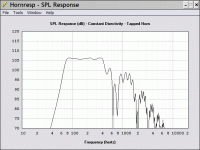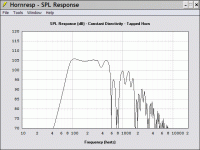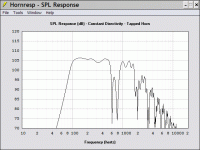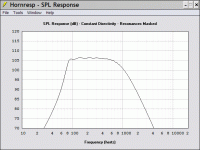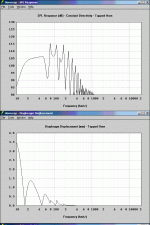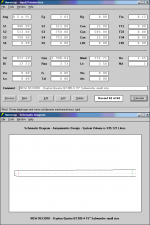Thanks muchly GM!
(due to new & still unresolved home network problems, still unable to download/ install Hornresp)
Not sure I understand all of your posts correctly, but as it reads to me (in this 40! degree C local heat ~105! F, brain semi meltdown):
you simmed the Focal in Hornresp (the 1st screen dump) and it's clearly a bit too ripply.
You then simmed the PHL "using ML's math", and in Hornresp(?)
If I understand you correctly -
With series R compensation, the 320 Hz TH was smoothed; but in the 615 Hz TH, efficiency was lowered without any smoothing; and a 615 Hz PHL TH was the better damped = smoother, and much smaller than the 320 Hz TH.
TH 101: what is the physical horn difference between THs of different upper cutoffs, ie 615 Hz and 320 Hz - eg a different length/ flare rate??
The best option looks like a PHL in 615 Hz without R compensation - do you have a screen dump of it's FR, and the assumed physical dims (line length, tap point, mouth, etc)?
> How do you build a tapped horn without a fold
My bad English. Instead of saying "initially without a bend, and one added later", I should have said "initially with 'box' corners, and smoothing of bends done later"
Cheers
(due to new & still unresolved home network problems, still unable to download/ install Hornresp)
Not sure I understand all of your posts correctly, but as it reads to me (in this 40! degree C local heat ~105! F, brain semi meltdown):
you simmed the Focal in Hornresp (the 1st screen dump) and it's clearly a bit too ripply.
You then simmed the PHL "using ML's math", and in Hornresp(?)
If I understand you correctly -
With series R compensation, the 320 Hz TH was smoothed; but in the 615 Hz TH, efficiency was lowered without any smoothing; and a 615 Hz PHL TH was the better damped = smoother, and much smaller than the 320 Hz TH.
TH 101: what is the physical horn difference between THs of different upper cutoffs, ie 615 Hz and 320 Hz - eg a different length/ flare rate??
The best option looks like a PHL in 615 Hz without R compensation - do you have a screen dump of it's FR, and the assumed physical dims (line length, tap point, mouth, etc)?
> How do you build a tapped horn without a fold
My bad English. Instead of saying "initially without a bend, and one added later", I should have said "initially with 'box' corners, and smoothing of bends done later"
Cheers
midbass folded FLH v TH
GM,
Rather than max BW or bottom end (I'll use a sub below) the aim is minimal distortion and colorations
> You can fold a FLH too.
Very good point - over the same broadly midbass 90 - 360 Hz range (with the PHL) how would a folded FLH be likely to compare with a TH??
I also need to have construction KISS, which is what attracted me to THs . .
Thank you
GM,
Rather than max BW or bottom end (I'll use a sub below) the aim is minimal distortion and colorations
> You can fold a FLH too.
Very good point - over the same broadly midbass 90 - 360 Hz range (with the PHL) how would a folded FLH be likely to compare with a TH??
I also need to have construction KISS, which is what attracted me to THs . .
Thank you
Re: midbass folded FLH v TH
Greets!
You're welcome!
Oooh! I've worked/suffered through such heat and it can literally be a killer, so keep yourself well hydrated, protect skin, etc..
Correct. Apparently, the wider BW's smaller throat to a smaller mouth damped it enough to negate the electrically added damping alignment.
On a TH, 'Fh' sets the driver's location along its length.
OK, a good plan considering we're not sure if we want the extra HF output a smooth bend implies. I know in simple pipe horns we keep the bends 'crude' and sometimes even add damping in the bend(s) to tone down its HF output and if I ever get to build any TH's, I'll be experimenting with damping to smooth less than optimum alignments.
GM
Greets!
You're welcome!
Oooh! I've worked/suffered through such heat and it can literally be a killer, so keep yourself well hydrated, protect skin, etc..
Correct. Apparently, the wider BW's smaller throat to a smaller mouth damped it enough to negate the electrically added damping alignment.
On a TH, 'Fh' sets the driver's location along its length.
OK, a good plan considering we're not sure if we want the extra HF output a smooth bend implies. I know in simple pipe horns we keep the bends 'crude' and sometimes even add damping in the bend(s) to tone down its HF output and if I ever get to build any TH's, I'll be experimenting with damping to smooth less than optimum alignments.
GM
Just thought I'd add an experience of mine.
I was testing out my LM3875 chipamps bridged into my tapped horn. I am very impressed by the sheer efficiency of tapped horns. My amp has 25V rails, and was putting out 20Vrms into a 4R load. So only about 100 watts or so. It was pretty impressive. It would be very easy to make your own DIY active subwoofer, right down to the amp and everything. The thing I like the most about my TH is that it can keep up with the full range speakers, with the same power.
I was testing out my LM3875 chipamps bridged into my tapped horn. I am very impressed by the sheer efficiency of tapped horns. My amp has 25V rails, and was putting out 20Vrms into a 4R load. So only about 100 watts or so. It was pretty impressive. It would be very easy to make your own DIY active subwoofer, right down to the amp and everything. The thing I like the most about my TH is that it can keep up with the full range speakers, with the same power.
Why? Even if you want a lowest useablr F of an octave below that, a simple conical will likely have less artifacts from the horn. See Adrian Mack's A6 conical for example.otto88 said:The best option looks like a PHL in 615 Hz without R compensation
XJ-15 tapped horn similation
Hello GM:
I really appreaciated you taking the time to run some sims on my sub. I am still trying to get my head around the s1 - s4 thing. I read Buzzy's post and the replies and I think I got it. Once I figure out how to post an image I will send you what I think it looks like. Thanks agiain.
Hello GM:
I really appreaciated you taking the time to run some sims on my sub. I am still trying to get my head around the s1 - s4 thing. I read Buzzy's post and the replies and I think I got it. Once I figure out how to post an image I will send you what I think it looks like. Thanks agiain.
> On a TH, 'Fh' sets the driver's location along its length.
Fh is a setting within hornresp? (I should be able to get hornresp going on the weekend)
Posted by Brett
Even if you want a lowest useable F of an octave below that, a simple conical will likely have less artifacts from the horn. See Adrian Mack's A6 conical for example.
I wanted something that won’t take too long to build. That’s what attracted me to the TH. I’d expect a straight conical to be cleaner, but by how much; and a TH vs a folded FLH . .
Originally posted by otto88
The best option looks like a PHL in 615 Hz without R compensation
Posted by Brett
Why?
I wasn’t sure that I understood GM correctly. I thought that amongst the TH options canvassed, that was what *he was saying - am I wrong?
Thanks
Fh is a setting within hornresp? (I should be able to get hornresp going on the weekend)
Posted by Brett
Even if you want a lowest useable F of an octave below that, a simple conical will likely have less artifacts from the horn. See Adrian Mack's A6 conical for example.
I wanted something that won’t take too long to build. That’s what attracted me to the TH. I’d expect a straight conical to be cleaner, but by how much; and a TH vs a folded FLH . .
Originally posted by otto88
The best option looks like a PHL in 615 Hz without R compensation
Posted by Brett
Why?
I wasn’t sure that I understood GM correctly. I thought that amongst the TH options canvassed, that was what *he was saying - am I wrong?
Thanks
All the TH sims have a ton of artifacts up high, as you would expect from something summing the front an rear waves of the same driver's radiation within an enclosure. Good at long wavelengths.otto88 said:Posted by Brett
Even if you want a lowest useable F of an octave below that, a simple conical will likely have less artifacts from the horn. See Adrian Mack's A6 conical for example.
I wanted something that won’t take too long to build. That’s what attracted me to the TH. I’d expect a straight conical to be cleaner, but by how much; and a TH vs a folded FLH . .
But let's be realistic; how is a conical flare any more difficult to make than a TH?
otto88 said:
.......the aim is minimal distortion and colorations
........over the same broadly midbass 90 - 360 Hz range (with the PHL) how would a folded FLH be likely to compare with a TH??
Thank you
Greets, part deux!
You're welcome!
Probably no comparison. As I noted at the beginning, I wouldn't use a TH in this BW based on what little I currently know about them. I'd have to be desperate for a compact system to even consider it and have plenty of digital EQ available to tame it if I couldn't do it with internal damping without a major loss of efficiency.
That said, an 'ideal' T/S max flat BP alignment yields the best performance AFAIK, but the driver has to have the 'right' specs for the desired gain BW and it will be huge since the only thing controlling its performance is the sheer mass of air 'trapped' in the horn.
For example, changing the Focal's Fs, Qes to an 'ideal' driver for a 56.56 - 320 Hz alignment with loading to 80 Hz requires 365.625 L net according to Hornresp, but you get what you 'pay' for:
GM
Attachments
If you optimize Fs, Qes for the 80-320 Hz BW, which yields even better performance due to a smaller gain BW, it jumps up to a whopping 528.141 L, but its electro-mechanical damping is equally impressive compared to the others, though don't have a clue how audible the differences are other than its increased peak power handling:
Attachments
Now, using the 'ideal' Fs, Qes driver that requires 365.625 L net in a TH and letting Hornresp auto calc an 80 - 320 Hz FLH, it's 275.111 L net, 129.49 cm long terminating into a 7,356.94 cm^2 mouth. Not exactly small, but on paper it outperforms the 578+L TH in every simmed way enough to make it the 'no-brainer' choice of the bunch IMO:
Attachments
Brett,
> How is a conical flare any more difficult to make than a TH?
Curves are harder to make – but you’re referring to straight conicals?
In straight conicals, there’s mitre joins - I haven’t done them.
> the TH sims have a ton of artifacts up high
You’ve led me to think more about the FR above BW. I don’t want artefacts, but hadn’t previously considered . .
GM,
Thank you very much for your sims and graphs!!
As you’ve also made clear, I was looking to save size, but the compomnises are much greater than I thought. As you say - you get what you 'pay' for
How did you determine the 'ideal' Fs & Qes, and what were they?
Thank you
> How is a conical flare any more difficult to make than a TH?
Curves are harder to make – but you’re referring to straight conicals?
In straight conicals, there’s mitre joins - I haven’t done them.
> the TH sims have a ton of artifacts up high
You’ve led me to think more about the FR above BW. I don’t want artefacts, but hadn’t previously considered . .
GM,
Thank you very much for your sims and graphs!!
As you’ve also made clear, I was looking to save size, but the compomnises are much greater than I thought. As you say - you get what you 'pay' for
How did you determine the 'ideal' Fs & Qes, and what were they?
Thank you
If it has curves, it's not conical. You're still going to need to do a mitre in a TH.otto88 said:Brett,
> How is a conical flare any more difficult to make than a TH?
Curves are harder to make – but you’re referring to straight conicals?
In straight conicals, there’s mitre joins - I haven’t done them.
My woodworking skills are pretty meagre, but even I can manage a conical flare. Next weekend I'll be making a new mid for my KHorns with nothing but wood, glue etc, circ saw, large square and two clamps.
Killjoy said:
I am still trying to get my head around the s1 - s4 thing.
Greets!
You're welcome!
Hmm, Buzzy's drawing doesn't look right to me. This is the Hornresp layout as I understand it: http://img155.imagevenue.com/img.php?image=05613_Tapped_horn_Hornresp_122_1037lo.JPG
S1 = throat area (St)
S2 = horn area at the centerline of the driver nearest the throat
S3 = horn area at the centerline of the driver nearest the mouth
S4 = mouth area (Sm)
Note that if you make the box width/depth ratio 1:1.4142, then the distance from the divider baffle to the three sides is equal at (depth - baffle thickness)/2. Note too that the angled corner baffles have no measurable effect in the LF, though some damping there to reduce the amplitude of standing waves may be beneficial.
GM
otto88 said:
Thank you very much for your sims and graphs!!
How did you determine the 'ideal' Fs & Qes, and what were they?
Greets!
You're welcome!
I learned enough T/S theory to apply it to horn design theory.
As the old saying goes, the few spoil it for the many.
GM
Brett said:If it has curves, it's not conical.
Hi Brett,
It is probably worth clarifying that it is possible for a rectangular "conical horn" to have curved sides - it all depends on the aspect ratios of the throat and mouth. This can be readily demonstrated in Hornresp by exporting conical horn schematic diagram data, and charting the height and width results in Excel. Remember, it is only the cross-sectional area that is required to obey the conical expansion law.
It is interesting to note that the great Paul Klipsch himself originally thought that the initial "rubber throat" in his famous Klipschorn had a conical flare rate, when in fact it was parabolic - even though all the panels were flat (two parallel and two tapered).
Kind regards,
David
Hi David. Of course you are correct; I was thinking too simplistically. Cheers.David McBean said:
Hi Brett,
It is probably worth clarifying that it is possible for a rectangular "conical horn" to have curved sides - it all depends on the aspect ratios of the throat and mouth. This can be readily demonstrated in Hornresp by exporting conical horn schematic diagram data, and charting the height and width results in Excel. Remember, it is only the cross-sectional area that is required to obey the conical expansion law.
It is interesting to note that the great Paul Klipsch himself originally thought that the initial "rubber throat" in his famous Klipschorn had a conical flare rate, when in fact it was parabolic - even though all the panels were flat (two parallel and two tapered).
Kind regards,
David
When I get home in a couple of weeks, I'm going to try a new conical, cone driven midhorn for my1974 KHorns. Providing we can actually get the bass section upstairs.
Sims
Hello GM:
Over the weekend I ran a Dayton Quatro 15" from parts express through Hornresp. Can you tell me if these look good. I'm not sure that I am under standing the x-max in the displacement diagram correctly. I remember someone mentioning that you are supposed to be able to determine what the max excursion will be at what power. Volvoteer mentioned this in one of his posts, but I didn't see how he determined this. Thanks.
BTW, I also ran the Dayton Quatro 10" and it also looks good. I ran the LAB12 too, and got similar results as posted below.
Hello GM:
Over the weekend I ran a Dayton Quatro 15" from parts express through Hornresp. Can you tell me if these look good. I'm not sure that I am under standing the x-max in the displacement diagram correctly. I remember someone mentioning that you are supposed to be able to determine what the max excursion will be at what power. Volvoteer mentioned this in one of his posts, but I didn't see how he determined this. Thanks.
BTW, I also ran the Dayton Quatro 10" and it also looks good. I ran the LAB12 too, and got similar results as posted below.
Attachments
- Home
- Loudspeakers
- Subwoofers
- Collaborative Tapped horn project
